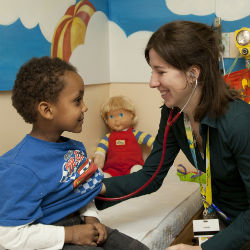Streamlined ER care to improve services

Thursday, February 3, 2011 - 11:13
By MONIQUE MUISE, The Montreal
A trip to the emergency room is almost always an unpleasant experience.
When a patient arrives, they're likely already in pain and the prospect of waiting for hours in a room crammed with sniffling adults and screeching babies only adds to the discomfort. The doctors, nurses and planners at the McGill University Health Centre were very much aware of this when they began mapping out the emergency facilities in Montreal's new superhospital; and while they aren't promising that the ER will become the city's new destination of choice, they are hoping to make it a far less gruelling experience.
"The absolute number of treatment spaces is not changing, but the configuration of the whole unit will be much different," explained Harley Eisman, director of Medical Emergency at the Montreal Children's Hospital. "Even as you arrive, it will be sheltered when you get out of your car ... which is different than what we have today."
The new ERs will offer a much more streamlined system for dealing with patients, Eisman explained. When a patient enters either an adult or pediatric ER -which will remain separate -they will be seen by a triage nurse and registered in the same room at the same time. They will then be assigned a treatment space based on their condition and the care they may need. Ideally, they won't leave that space until they leave the hospital, which the MUHC hopes will cut down on patient-shuffling and, therefore, reduce the spread of infections.
At night, when patient volumes drop dramatically, the emergency rooms will be able to physically "contract" along with them, Eisman explained, allowing the remaining staff to work more efficiently in closer quarters while maintaining good sight lines across the ER.
According to Micheline Ste-Marie, the associate director of Professional Services at the Chidren's, the ability to plan this new layout from scratch with the help of the doctors and nurses who will be using the facility has been a huge advantage.
"The initial functional plan was tabled in 2002," she said. "Then it sort of evolved. It certainly doesn't look like it did in 2002, because medical treatment is constantly evolving."
One thing a solid design won't address, however, is the perennial problem of overcrowding. Montreal
"The overcrowding problems will not disappear," Eisman acknowledged. "But the quality of care will improve significantly."
According to Ste-Marie, the best way to address overcrowding is still to focus on improving care in clinical settings outside the ER.
"Forty per cent of our ER patients really shouldn't be there," she said. "Instead of forcing them to wait for hours on end, they would be much better served at CLSCs ... or in other care settings. The push has to be outside, and then we can take care of those who really need it." © Copyright (c) The Montreal


